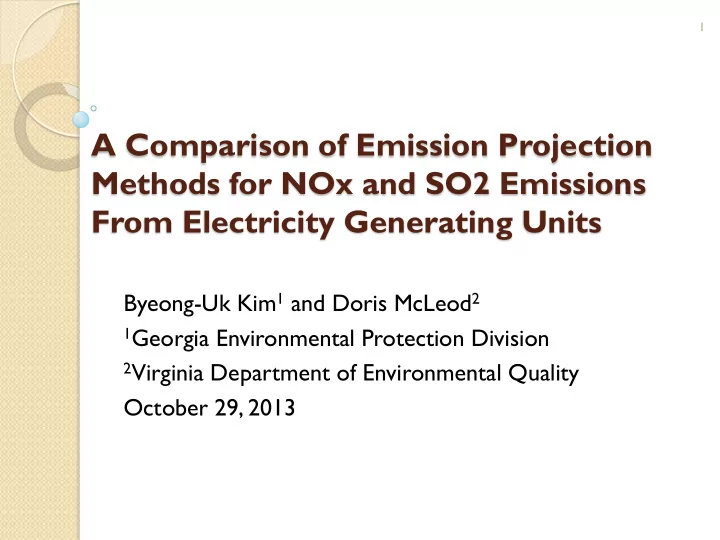

1 A Comparison of Emission Projection Methods for NOx and SO2 Emissions From Electricity Generating Units Byeong-Uk Kim 1 and Doris McLeod 2 1 Georgia Environmental Protection Division 2 Virginia Department of Environmental Quality October 29, 2013
2 Emission Projection Methods ERTAC EGU SEMAP IPM Projection T ool Description Heat input/generation Simple linear growth Considers complex economic • • • projection with controls and control factor interactions among energy Explicit energy demand application sectors including renewables and • distribution among units in No explicit nuclear • the same fuel type in the consideration about Proprietary model • same region energy demand among States do not have ability to • Open-source (Python and units replicate nor run sensitivity cases. • SQLite) Straightforward “Black Box” - Details about how • Easy and free to run implementation the model predicted certain unit- • level outputs are not known. Expensive to run • T emporal/Spatial Hourly Annual Annual and Ozone season • • • Continental United States SEMAP States: AL, FL, Continental United States Plus Coverage • • • GA, KY, MS, NC, SC, TN, VA, and WV Base Year 2007 (v1.7) and 2011 (v2.0) 2007 2006 Projection Year 2017, 2018, and 2020 2018 (v1c) 2020 Growth/Control AEO2013 growth factor: AEO2012 annual AEO 2010 information • • • annual, peak, and non-peak growth factor NEEDS v4.1 Information • GFs Control data supplied • Control data supplied by by SESARM states • states
3 Challenges in Cross-comparison Different levels for emissions ◦ IPM and ERTAC – Unit level ◦ SEMAP –Pseudo-Unit level (originally, process level) Fuel type mapping ◦ Fuel types are not necessarily same among IPM, ERTAC, and SEMAP All of ERTAC gas types are mapped to the generic ‘Gas’ type IPM’s “Natural Gas” type was mapped to the generic ‘Gas’ type Some units burn more than one type of fuel ◦ SEMAP approach does not need fuel types explicitly ORIS ID/CAMD Unit ID and Facility ID/State Unit ID were used to map fuel types from ERTAC data to SEMAP data followed by simpler fuel type mapping procedure Base year and projection year differences ◦ For this analysis, the following dataset were used: ERTAC v1.7 for 2018, SEMAP v1c for 2018, ERTAC v2.0 for 2020, and IPM v4.1 for 2020 Labeling for effective cross-comparison ◦ Some unique keys/names for the same units/facilities across all models
4 Coal: ERTAC and IPM Continental United States
Gas: ERTAC and IPM 5 Continental United States
6 SO2, Coal & Oil: ERTAC, IPM, and SEMAP SE States: AL, FL, GA, KY, MS, NC, SC, TN, VA, and WV SO2 (TPY)
7 NOx, Coal & Gas: ERTAC, IPM, and SEMAP SE States: AL, FL, GA, KY, MS, NC, SC, TN, VA, and WV NOx (TPY)
8 SO2, Coal SE States: AL, FL, GA, KY, MS, NC, SC, TN, VA, and WV Large variability in projected emissions SO2 (TPY)
9 NOx, Coal and Gas SE States: AL, FL, GA, KY, MS, NC, SC, TN, VA, and WV Large variability in projected emissions NOx (TPY)
NOx, Gas, New Unit and/or Generation Deficit Unit 10 SE States: AL, FL, GA, KY, MS, NC, SC, TN, VA, and WV Generation Deficit Units in SEMAP were assigned at unit-level. IPM’s new units are equivalent to ERTAC’s GDUs except they NOx (TPY) were assigned at state-level. New Units Existing Units Generation Deficit Units
11 SO2, Georgia Log Scale
12 SO2, Georgia, Coal, Facility High SO2 emissions from existing units or retired units in IPM results are due to out-dated input data. Because IPM is updated infrequently, it can be quickly out of date. SO2 (TPY) Missing new unit is also due to out-dated input data. IPM might shutdown Mitchell (GA) coal unit.
13 SO2, Georgia, Coal, Selected Facility, Unit Level Large variability in projected emissions SO2 (TPY) ERTAC and SEMAP use different names for new units.
14 NOx, Georgia
15 NOx, Georgia, Coal, Facility Level High NOx emissions from retired units in IPM results are due to out-dated input data. Because IPM is updated infrequently, it can be quickly out of date. Missing new unit is NOx (TPY) also due to out-dated input data. IPM might shutdown Mitchell (GA) coal unit.
16 NOx, Georgia, Gas, Facility Level NOx (TPY)
NOx, Georgia, 17 a specific facility, Unit Level ERTAC BY UF: ~60.0% (Coal) FY UF: 15.8 % (Gas) Emission could be this level if FY UF is about 60%. NOx (TPY) ERTAC T ool is transparent; users are able to understand outputs!
18 Summary ERTAC and IPM approaches produced comparable annual SO2 and NOx emissions at national level. ◦ However, OS NOx can be very different between ERTAC and IPM. ERTAC, SEMAP, and IPM provided comparable annual SO2 and NOx emissions at regional level. At state level and/or unit-level, however, projected emissions with different approaches showed great variability. IPM’s new units are equivalent to ERTAC’s GDUs except IPM’s new units are assigned at state-level while ERTAC’s GDU’s are at unit-level. When ERTAC model produces GDUs, users can determine the reason by analyzing outputs and inputs.
19 Conclusions For some units, IPM predicted much higher SO2 emission rates than SEMAP or ERTAC. For some units, three methods produced very different NOx emissions. IPM created new generation units and assigned no generation to a planned unit (i.e. Plant Washington). ◦ This is likely due to out-dated NEEDS DB. ERTAC Tool is transparent; users are able to determine the reasons for outputs. Cross-comparison of results of differe nt EGU emission projection approaches provides valuable insights. A cross-walk table needs to be developed to conduct this type of cross-comparison efficiently and more accurately.
20 Contact Information Byeong-Uk Kim, Ph.D. Georgia Dept. of Natural Resources 4244 International Parkway, Suite 120 Atlanta, GA 30354 Byeong.Kim@dnr.state.ga.us 404-362-2526
Recommend
More recommend